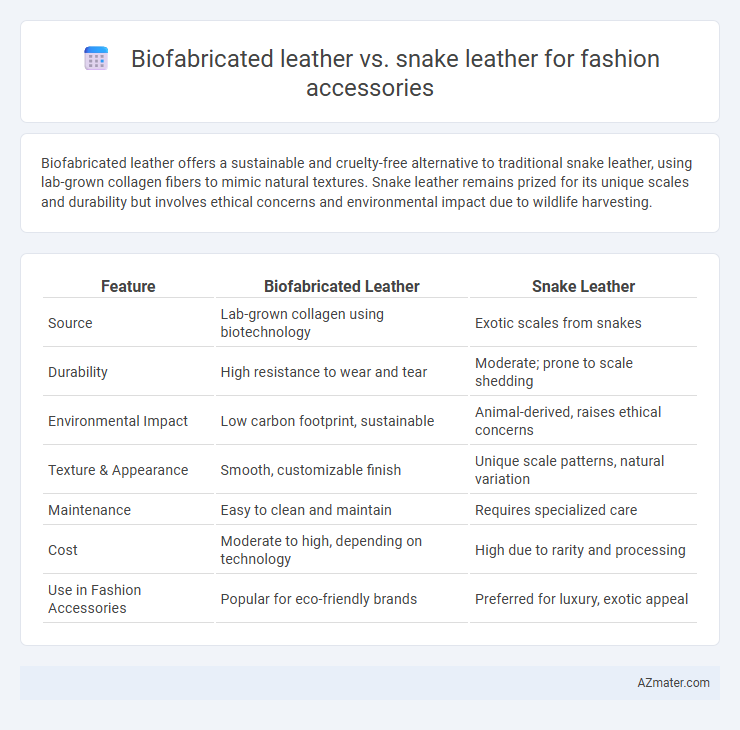Biofabricated leather offers a sustainable and cruelty-free alternative to traditional snake leather, using lab-grown collagen fibers to mimic natural textures. Snake leather remains prized for its unique scales and durability but involves ethical concerns and environmental impact due to wildlife harvesting.
Table of Comparison
| Feature | Biofabricated Leather | Snake Leather |
|---|---|---|
| Source | Lab-grown collagen using biotechnology | Exotic scales from snakes |
| Durability | High resistance to wear and tear | Moderate; prone to scale shedding |
| Environmental Impact | Low carbon footprint, sustainable | Animal-derived, raises ethical concerns |
| Texture & Appearance | Smooth, customizable finish | Unique scale patterns, natural variation |
| Maintenance | Easy to clean and maintain | Requires specialized care |
| Cost | Moderate to high, depending on technology | High due to rarity and processing |
| Use in Fashion Accessories | Popular for eco-friendly brands | Preferred for luxury, exotic appeal |
Introduction to Biofabricated Leather and Snake Leather
Biofabricated leather, created through cell culture technology, offers a sustainable alternative to traditional materials by mimicking the texture and durability of animal hides without the environmental impact of conventional leather production. Snake leather, prized for its distinct scale pattern and exotic appeal, is sourced from real reptiles, often favored for luxury fashion accessories that emphasize rarity and unique aesthetics. Both materials cater to high-end fashion markets, with biofabricated leather gaining traction as an eco-friendly innovation, while snake leather remains valued for its natural authenticity and patterning.
Material Origins: Lab-Grown vs Natural Sourcing
Biofabricated leather originates from lab-grown materials created through cellular agriculture techniques, offering a sustainable alternative by eliminating the need for animal harvesting. Snake leather is sourced naturally by harvesting skins from snakes, often involving ethical and environmental concerns related to wildlife and habitat disruption. The lab-grown process allows for controlled production with reduced ecological impact, while snake leather remains a traditional but less sustainable luxury material in fashion accessories.
Sustainability Impact in Fashion Industry
Biofabricated leather, created through microbial fermentation and plant-based materials, offers a sustainable alternative to traditional snake leather by significantly reducing environmental impact, such as lowering carbon emissions and water usage. Snake leather production involves ethical concerns related to wildlife exploitation and habitat disruption, contributing to biodiversity loss and regulatory challenges in the fashion industry. Adopting biofabricated leather promotes circular economy principles, decreases reliance on animal-derived products, and aligns with eco-conscious consumer trends driving sustainability in fashion accessories.
Ethical Considerations: Animal Welfare and Beyond
Biofabricated leather offers a sustainable and cruelty-free alternative to snake leather, eliminating the need for animal farming and skin harvesting, thereby significantly reducing animal suffering. This innovative material lowers environmental impact by avoiding deforestation, habitat destruction, and toxic chemical use commonly associated with traditional leather tanning. Emphasizing ethical fashion, biofabricated leather supports transparent, eco-conscious supply chains while promoting biodiversity preservation beyond mere animal welfare.
Environmental Footprint: Production and Disposal
Biofabricated leather significantly reduces environmental footprint by eliminating animal farming, lowering greenhouse gas emissions, and minimizing water usage compared to traditional snake leather. Production of biofabricated leather relies on lab-grown materials, drastically cutting deforestation and habitat destruction linked to snake farming and hunting. Disposal of biofabricated leather is often more eco-friendly and biodegradable, whereas snake leather involves tanning processes with toxic chemicals that pose disposal challenges and environmental pollution risks.
Design Versatility and Aesthetic Options
Biofabricated leather offers unparalleled design versatility with customizable textures, colors, and finishes that can mimic or surpass traditional materials, enabling innovative and sustainable fashion accessories. Snake leather features naturally unique scale patterns and rich textures, providing luxurious and exotic aesthetics favored in high-end designs but limited in color variation and pattern alteration. Fashion designers seeking eco-friendly options benefit from biofabricated leather's adaptability, while those prioritizing authenticity and traditional craftsmanship often prefer snake leather's distinct visual appeal.
Durability and Functional Performance
Biofabricated leather offers superior durability compared to snake leather, resisting wear, moisture, and temperature fluctuations while maintaining structural integrity. Snake leather is prized for its unique texture but tends to be less resilient, prone to cracking and fading under regular use. Functional performance in biofabricated leather includes enhanced flexibility and water resistance, making it ideal for long-lasting fashion accessories.
Consumer Perceptions and Market Trends
Biofabricated leather is gaining traction in the fashion accessory market due to its sustainability, cruelty-free production, and innovative appeal, attracting eco-conscious consumers seeking alternatives to traditional materials. Snake leather remains popular for its exotic texture and luxury status, appealing to consumers who value authenticity and high-end craftsmanship despite ethical concerns. Market trends indicate a growing shift towards biofabricated leather as brands respond to increasing demand for environmentally responsible products, while snake leather experiences niche demand in luxury segments.
Cost Comparison and Accessibility
Biofabricated leather offers a sustainable alternative to snake leather, often costing 20-30% less due to scalable lab production and reduced animal farming expenses. Snake leather remains expensive, with prices influenced by rarity, complex tanning processes, and limited supply chains, making it less accessible to mainstream fashion brands. The growing availability of biofabricated leather enhances accessibility for a wider range of designers seeking eco-friendly and cost-effective materials.
Future Prospects: Innovations and Market Growth
Biofabricated leather leverages biotechnology to create sustainable, cruelty-free alternatives with customizable textures and enhanced durability, driving significant innovation in the fashion accessory market. Snake leather, prized for its unique patterns and luxury appeal, faces ethical and environmental challenges that limit scalability, prompting designers to explore synthetic and biofabricated substitutes. Market growth favors biofabricated leather due to increasing consumer demand for eco-friendly materials, regulatory pressures, and advances in production scalability that reduce costs and expand adoption.

Infographic: Biofabricated leather vs Snake leather for Fashion accessory
 azmater.com
azmater.com